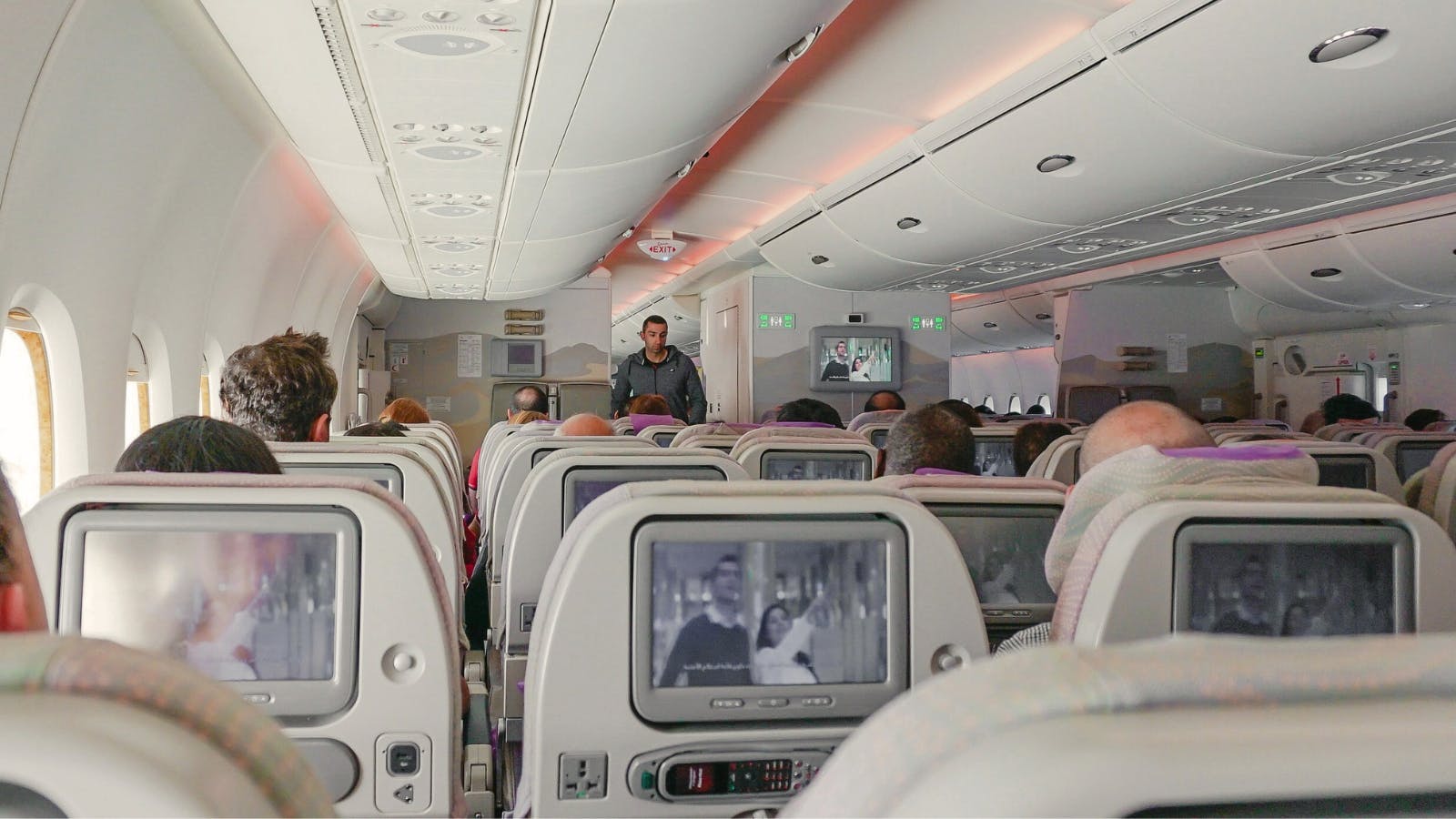It turns out distributed ad networks operated by travel and tourism companies have some things that traditional grocery and retail media ecosystems don’t – like the ability to break into the luxury vertical and connect with audiences across a long customer journey. Branded messages are coming to some airplane seatback screens, thanks to new retail media networks / Toa Heftiba In June, United debuted Kinective Media, its proprietary media network, and the first in the airline industry. The network will allow advertisers to buy ads on seatback screens, across United’s website and mobile app and in out-of-home airport placements.
The company has also partnered with sell-side firm Magnite to bring ads to customers’ own devices when they use United’s in-flight personal device entertainment system. Early brand partners include Norwegian Cruise Line, Macy’s and TelevisaUnivision. Increasingly, travel, tourism and transport companies – including United, Marriott, Expedia, Uber, Lyft and more – are launching their own ad networks, spin-offs of retail media’s boom of the last few years.

At Cannes Lions in June, the ad industry’s most prestigious annual celebration, United promoted Kinective Media alongside more traditional grocery and retail media network owners like Amazon, Target, Walmart, Kroger, Albertsons and Instacart. In fact, many ad industry insiders are urging brands to stop thinking about these kinds of custom, distributed networks – which are also popping up in the financial services sector, with Chase, Paypal and Revolut throwing their hats into the ring – as ‘retail media networks.’ It’s an expanding category.
“It’s really just commerce media,” says Sean Crawford, a managing director at Threefold, a retail media network agency. “It’s anything where a customer transacts with an institution or an organization ..
. as long as you have a strong database that is ..
. compliant [with privacy regulations], you have a good audience of endemic brands that you can target and you have a really strong base to build a network off the back of, which can then attract non-endemic [brands] as well.” Custom media networks built by travel and financial services companies make sense, in Crawford’s telling, precisely because of the opportunity to do what Kroger, Walmart, et.
al. have already done: cash in on their wealth of first-party data. “Because retailers have [succeeded], you’ve now got the wider industry jumping on that bandwagon and going, ‘We have all this data .
.. How can we work with partners to make our customer experience richer, whilst also ultimately making ourselves more profitable by selling that data?,” he says.
This explanation for the explosion of distributed ad networks resonates with United’s Richard Nunn, who serves as CEO of United Airlines MileagePlus. He says we’re seeing “a massive shift to any vertical has got first party data, because [that data represents] real people who buy stuff.” He suggests that “that’s valuable in itself,” especially when compared with the widespread issues of viewability, verification and ad fraud that advertisers often encounter with publishers.
The opportunity to enhance campaign measurement – and attribution in particular – is also attractive to brands. In a closed-loop ecosystem, it’s easier to prove attribution, Nunn points out. But a few factors make travel, tourism and transport companies especially well-positioned to succeed in retail media.
Swapping CPG for luxury brands, and performance for brand A real differentiator for travel and tourism is the relative value of audiences. Traditional retailers and grocers have “done a great job in terms of the CPG [or consumer packaged goods] vertical,” Nunn says, but are “struggling to break into other verticals like luxury, auto or finance – anything outside of CPG.” Travel and tourism customers, meanwhile, tend to be “very high-value audiences in terms of household income,” creative a valuable in for up-market brands.
United has made it a point to target these kinds of advertisers. And luxury brands across fashion, automotive and finance tend to prioritize brand-level marketing – investing in striking out-of-home visuals or multimillion dollar TV spots – rather than lower-funnel performance marketing. Where retail media networks operated by the likes of Walmart and Albertsons have offered primarily performance marketing opportunities, United is interested in “playing in the brand space,” Nunn says.
Advertisement It’s an ambition that will be aided by the fact that the airline owns hundreds of thousands of screens on seatbacks, at gates and in airport lounges. “There's a lot of downtime where you have a screen in front of people. In the plane, they're strapped in – they're not going for a coffee break during the ad break.
Albeit, we're early into our launch, but we can play very, very well in [both] brand and performance, and that does give us a point of differentiation,” Nunn says. One of United’s first Kinective Media partners, IHG Hotels – the parent company of premium hotel collections including Intercontinental and Regent as well as budget brands like Holiday Inn – prioritized contextual ads in United Club lounges, on gate information displays and on seatback screens during flights. Targeting business, family and luxury audience segments, IHG’s campaign saw more than a 97% video completion rate and a 2.
8% interaction rate on inflight entertainment among the highest-performing audience segments. Connecting the dots across the customer journey Beyond the potential for attracting ad dollars from premium brands and playing at the brand level as well as the performance level, another reason for the rise of travel and tourism media networks is their ability to connect the dots across long customer journeys. “There is a particularly strong value-add in travel because the consumer journey for our industry is so complex,” says Rob Torres, senior vice-president of Expedia Group media solutions.
“Fragmentation plays a significant role here. On average, travelers view 141 pages of travel content in the 45 days before booking a trip. For destination marketers, this is compounded by the fact that 59% of travelers do not have a specific destination in mind or have already considered multiple destinations after making the decision to travel.
This makes it harder for advertisers to get in front of the right traveler at the right time.” A travel media network – like the one launched by Expedia in May – can offer a closed-loop solution. “Our travel media network offers advertising partners a one-stop shop, from onsite to offsite activations, and creative campaigns to insights-led media planning.
And while advertisers could certainly pay a team of media planners to reach travelers across various platforms, it can be time-consuming and expensive.” Advertisement Offsite capabilities, which Expedia is focused on expanding, are becoming especially valuable for reaching consumers across the full customer journey. As United’s Nunn puts it: “That customer journey is not just on the day of travel – it’s pre-, during and post-[travel].
[There is] value in terms of data, but also value in terms of understanding that person’s journey, in all senses that word.” Threefold’s Crawford gives an example of arriving at the airport only to realize you’ve forgotten your headphones. “Media can absolutely enhance that opportunity for travelers and make it a much better experience,” he says.
“I would love to be served bespoke adverts that are based on my data, my shopping history, brands that I have affinity for, if it’s going to help take the stress out of travel.” Considering touchpoints across the full customer journey also opens up new possibilities for ad networks like those owned by United and Expedia to partner up with travel, tourism and transport-focused companies like hotel groups, ridesharing platforms, travel accessories retailers and more. “There are certain data points that each of us [in the travel, tourism and transport space] would want to understand and value,” says Nunn.
“A rideshare company would love to understand where you’re flying to next Tuesday, and we know that data. A hotel group might find the same thing [valuable], right?” Sharing this kind of information with partners across the customer journey can add value by expanding a network’s dataset – while also creating a more seamless customer experience. As an example, Crawford says, “I'm an Uber customer, and I love the fact that they know that I am landing in the city and will be like, ‘Here’s a deal with Uber to get you from the airport to wherever you need to go.
’ Then ...
[maybe I’m] traveling to the city, and they recognize the time of day and say, ‘You must be hungry. Do you want to order in to your hotel? And here’s a deal to help you do that. We know you like Mexican food, so we’ve shortlisted the Mexican restaurants that are available.
’” United, for its part, has an ongoing strategic partnership with Marriott, which itself launched a media network in 2022. The companies share customer data to improve their ad offerings and elevate the customer experience. Crawford sums it up neatly, saying: “[Commerce] media has to be additive, it has to be something that enhances the customer experience.
And that can be done really well in the travel space with a partnership model between things that make sense when you’re in that travel mindset.” The same kind of collaboration could work within the same vertical – say, airlines – but across regions, too. Perhaps a regional airline that operates primarily in the North links up with an airline that services the South, Crawford says.
Their customer sets don’t overlap much, so they aren’t in direct competition. But they could improve the scalability and value of their data significantly by sharing information with one another. The cookie question For advertisers, one of the biggest selling points of retail and commerce media in recent years has been access to scores of first-party data – an obvious advantage at a time of cookie deprecation and prolific signal loss on the open web.
But last month, Google shocked adland with the news that it’s walking away from its years-long plan to sunset third-party cookies on Chrome . Instead, the search giant will soon prompt users to set preferences across Google-owned environments, but cookies will remain enabled for those who don’t switch them off. Catch up on the most important stories of the day, curated by our editorial team.
See the best ads of the last week - all in one place. Learn how to pitch to our editors and get published on The Drum. Although third-party cookies are already blocked on Apple’s Safari and Mozilla’s Firefox – and both Apple and Google have implemented new limits on user-level tracking on mobile – it’s estimated that Chrome still controls over 65% of the browser market.
So will the decision to keep third-party cookies on Chrome diminish any of the purported value of commerce media networks – and travel networks in particular? Experts aren’t convinced that distributed ad networks will lose their shine in advertisers’ eyes – because they see signal loss as a slow but surefire approaching tide. “Google has definitely thrown a spanner in the works ..
. [but] the industry was preparing for no cookies,” says Crawford. “Many of those companies are going to continue down that path with the expectation that at some point, [cookie deprecation] is going to happen.
It might not be happening now; it might be happening next year; but it will probably happen at some point.” Advertisers of all kinds will continue demanding cookieless targeting and measurement solutions, Crawford predicts. “They’ve invested millions of dollars preparing for it – they're not just gonna pull the plug.
” It’s a belief shared by Nunn, who says that investment in companies who own large first-party datasets “is still going to move radically fast, because [that data represents] real people who buy stuff, [which] become very, very valuable for a third-party advertiser.” It’s also likely that leaning into cookie-free ad targeting and measurement will help bring advertisers and publishers into compliance with a growing patchwork of privacy regulations across the globe. Going cookieless, Crawford says, is ultimately going to be the smart move for future-focused organizations – an argument that reinforces the case for media networks’ lasting value.
“Marketers who are saying, ‘Let's get privacy-ready, let’s get cookie-ready,’ are the ones who are actually setting businesses up for the future. And therefore, I’d argue that media networks are actually really well-positioned to take a slice of [ad spend], because it's more traditional media – the ones that rely on cookies and don’t really have anywhere to go that have a problem.” Travel media’s next destination There are still a number of new frontiers to be explored via travel and tourism ad networks.
One of the biggest opportunities that’s yet to be claimed across the customer journey, Crawford argues, is physical retail – in airports, railway stations or transport hubs. “No one’s owning that space from a retail media point of view” quite yet, he says. The right partnerships, he says, “could create some really great media campaigns that link through those retail experiences in the airport that are tied to business [or luxury] customers.
You could do some brilliant stuff in big vacation destinations with international hubs in the US, too.” Meanwhile, Expedia is seeking ways to connect with audiences in the environments they’re already spending time in and in ways that feel natural. For example, Torres says, “More than half of consumers say TV shows and movies inspire travel plans, so we launched an interactive, shoppable streaming platform .
.. where an advertiser’s content can be shopped as it’s being viewed.
” Expedia is also investing in the creator economy, where Torres says influencers have become a “new class of travel agents.” Considering that the vast majority of travelers turn to social media for inspiration when planning a trip, Expedia rolled out Travel Shops in mid-May, an experience “where top influencers can create customized, shoppable marketplaces in the Expedia app and across all Expedia points of sale,” according to Torres. It’s a medium for travel destinations to expand their reach and grow bookings, while also enabling creators to cash in on commissions.
At United, Nunn sees the potential for innovating the inflight media and entertainment experience to better reflect the social-focused environments that dominate consumers’ day-to-day lives. “Think about all the extraordinary technology that lives on earth, and how we consume content and snap content 24/7 across multiple devices. And then you go into a plane today, and it’s a very different experience.
There is a huge opportunity to change the kind of media and entertainment experience in flight.” As it stands, there are nearly 200 commerce media networks on the market, being made more crowded by the debut of new networks in travel and tourism and financial services. Crawford, for his part, predicts that they won’t all survive.
“Because so many networks have launched, and a lot of them have launched very quickly, there’s going to be a consolidation in the market. If you're, if you're a brand marketer, how do you work with 200 networks? There has to be a consolidation route moving forwards – whether that is provided by a piece of technology, or whether that is provided by non-competitive networks joining forces.” In the end, he predicts that the industry’s winners will be those who have the right combination of data, customer experience and partnerships.
“The networks that will really succeed,” he says, “are the ones who have that sweet spot of a really good data set, active customers, a really strong endemic play and then a really nice nod to non-endemic, which work with relevant partners.” For more, sign up for The Drum’s daily newsletter here ..



















